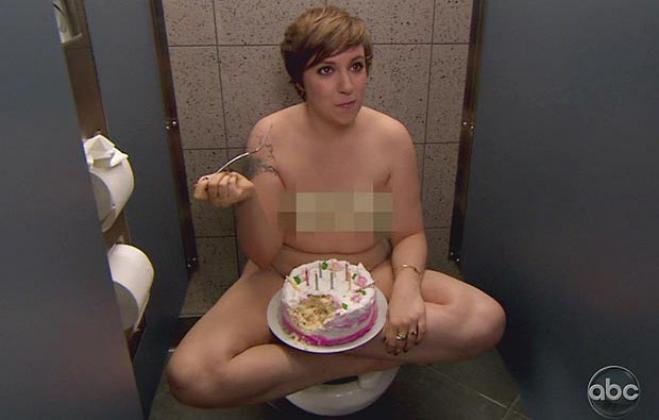These days, we’re not exactly unaccustomed to seeing acres of bare flesh romping across our television screens. Count the minutes down to the watershed, and then suddenly everything’s less CBEEBIES and more CBOOBIES (Game of Thrones springs particularly to mind, here). Apart from amongst the most prudish of us, nudity on TV is now accepted as perfectly normal. So when someone undressing onscreen causes a bit of a stir, it’s worth taking a look at why.
Series two of HBO’s Girls has just started airing across the pond, and with it comes a return of the palaver surrounding Lena Dunham’s oft-disrobed body. American shock-jockey Howard Stern this week caused controversy by declaring that being subjected to Dunham in the altogether “kind of feels like rape” (yes, Howie, that is exactly what rape is like – something you can flip off with a switch), and the New York Post was only slightly less offensive, referring scathingly to her on-screen nudity as “pathological exhibitionism”. For all the howls of enraged anguish, you’d think that the girl had literally barged into everyone’s kitchens whilst they were having breakfast and whacked her baps out all over the table.
But no: the only thing that Dunham is ‘guilty’ of is not having the type of body we’re used to seeing on television sets and in the media. This isn’t the picture-perfect, unrealistically-proportioned body that’s been airbrushed to within an inch of its life. It’s a body that you wouldn’t be particularly surprised to see in your mirror, or inhabiting the outfits of friends - and which is all the more remarkable for its being unremarkable.
For all the championing of “healthy body image” and so-called “real women” that women’s mags often cynically pretend to employ (whilst simultaneously ripping celebrities to shreds for having the merest hint of cellulite), the range of what variety of female body is deemed attractive is still as narrow as the women defined within it. This week, for example, Grazia is running a “Happy Body” issue, featuring a covershoot with Daisy Lowe. Lowe is described variously as “curvy”, “not skinny” and having “thunder thighs”, and is thus deemed suitable as the face of the campaign. And yet the next paragraph tells you that she is a tiny size eight - size eight, yet still regarded as being larger than what’s deemed usual or acceptable for female celebrities. And this is a campaign that is ostensibly claiming to challenge negative body image.
So there’s something progressive – almost revolutionary, in fact - about the approach to nudity in Girls. Rather than being sexualised flesh, designed to titillate, this is matter-of-fact flesh; uninhibited flesh that owns its own sexuality, and reminds us that there can be other reasons for nudity other than satisfying the male gaze. Dunham is as likely to be seen naked on screen eating cake as she is to be seen naked within a sex scene. More refreshing still is her refusal to apologise for not having the so-called “perfect shape”. “My response is, get used to it because I am going to live to be 100, and I am going to show my thighs every day till I die”, is her unapologetic reply to critics. APPLAUSE.
“Seeing the flab and the flaps and the veins and the cellulite and all those other little so-called 'flaws' that make a body a human body can be quite a shock when you're used to the plasticised vision of femininity that we're constantly bombarded with by magazines and advertising,” says Rhiannon Cosslet, editor of popular feminist blog Vagenda, “When you see another woman's body in real life, you suddenly think 'oh, I'm normal.' It's not just comforting, but a bit empowering too. You realise that it is, after all, just a body, and that we all have them.”
Personally, I like to take every opportunity to get my boobs out; they are a constant source of amusement to me. There is nothing that I ever don’t find hysterical about the fact that there are fleshy meat-sacks hanging off the front of me, billowing and dangling away down there. We have to live in our skin, every day, and my feeling is that we might as well get used to it. But that matter-of-factness is something that I’ve had to work on: attempting to feel free in my own skin, after a lifetime of being told that I shouldn’t be. I’m getting there.
The naked human body is a wonderful thing. It can be many things at once, some of which at first glance might seem contradictory. It can be grotesque and yet compelling; powerful and yet fragile; sexual and yet hilarious. And yet almost invariably, the version of it that we see in the media is a doctored, diminished one, stripped of all variety and charm. I think it’s high time we saw more unapologetic flesh, of every shape and size, represented on our screens.


Join our commenting forum
Join thought-provoking conversations, follow other Independent readers and see their replies